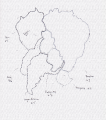Titan (working title)
“One who knows the depths of the whole sea, and keeps the tall pillars who hold heaven and earth asunder”
Homer, Odyssey
In the Greek mythology “Atlas” refers to a Titan that was punished by Zeus to carry the weight of the heavens and the earth forever on his shoulders. I always thought that this Atlas was the origin of the term atlas but as I began researching maps and map making I came across the Mauritanian King Atlas, who supposedly made the first celestial globe. It was this Atlas Gerardus Mercatror depicted on the title page of the “Theatrum Orbis Terrarum” in 1570, the first modern world atlas.
Still, the thought of the Grecian Atlas essentially carrying the world around on his shoulders was what reminded me of travel atlases and road maps. These are made for easy review during travels so the maps are largely zoomed and are used as reference for the depicted area. Folded flat you can carry them around in your pocket.
For my project I want to create a world map in the folded form of a travel atlas. This way one can carry the world like a modern day Atlas- just with a little less weight.
Using a topological map I want to relay information concerning the current earth population. I will disregard the normal scale and the spatial relations of a world map as I’m going to divide the countries into different categories according to their population. Each country in a category will be given the same proportions on the map so that obvious spatial discrepancies arise. To represent the unique individuals that make up the world population I will draw the map using only dots of differing size/strength.
The final product should be a double-hemisphere world map that reminds the viewer of the first atlases. Unfolded the map could have a size of 1m x 2m, folded of 0,1m x 0,2m.


